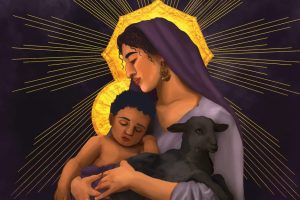This year, hand on heart, I saw Christmas decorations for sale on October 1. When I was little, we didn’t even start thinking about Christmas until after Thanksgiving.
My family would spend most of Advent getting ready. We’d shop for a tree, pull decorations down out of the attic, stock up on wrapping paper, and make lists for Santa. Most years the grownups would gather for a Christmas Eve party, and we kids would struggle to stay awake late into the night.
At the end of the evening, we’d bundle up against the cold and drive over to the church for Midnight Mass. Early the next morning my brothers and I would clatter down the stairs to the living room to tear into our presents. And then Christmas was over. For the next week or so, we played with our new toys and waited for school to begin again.
In the church calendar, however, Christmas does not end on Christmas Day. It is only the beginning. In an earlier time Christmas lasted for 12 days—a tradition from which we get the famous Christmas song.
The customs of the larger society have clearly shifted, and there is no way we are ever going to restore the ancient balance of having our Christmas merry-making take place during the 12 days after December 25. Still, there are many ways we can mark the Christmas season (the one that starts with Christmas), and deepen our Catholic identity. Here are 12 suggestions.
1. Wait for it
In our grandparents’ day the Christmas tree wasn’t decorated until Christmas Eve. For most of us, it might not be practical to wait until then, no matter what our grandparents might have done. Still there are some things we can do to keep the traditional Christmas cycle.
Go ahead and put up the tree whenever you like, but save placing the star on top until the night of December 24. Plan to leave the tree up until the Christmas season ends on the feast of the Baptism of the Lord, usually the second Sunday in January.
Also consider waiting until December 24 to complete the crèche. Many Latino families put the crèche out early in Advent, but they leave the manger empty until after Midnight Mass. Whenever you put the crèche out, place the Magi statues a good distance from the manger. Each day of Christmas, until Epiphany, move the Wise Men a little closer to the crèche.
This might seem like a no-brainer, but I’ve heard more than a few families say they like going to the Christmas “Eve” 4 p.m. children’s liturgy to “get it out of the way” before Christmas.
If you are raising children, keep in mind you are creating lifelong memories for them. I still remember the smell of incense and the sounds of carols at the Midnight Masses I went to as a child. If midnight really is too late for you, at least consider worshiping on Christmas Day itself instead of the afternoon before so the children learn to place Jesus at the center of the season.
2. Pay it forward
December 26 is the feast of St. Stephen, the church’s first martyr. He was also one of the first deacons, whose job it was to care for the poor.
A good way to celebrate St. Stephen’s Day is to follow his example. Spend 20 minutes online, either alone or as a household, researching poverty issues in your area. Make a commitment to volunteer or donate more during the coming year to serve the poor as Stephen did. Perhaps spend an hour on this day going through your closets and drawers to find clothing you seldom wear, and donate it to a shelter.
3. Pick a card
Another great way to keep the Christmas season alive is to gather up all the Christmas cards you’ve received and choose one at random each evening to read at dinnertime. If you live with family or a roommate, share some memories about the person who sent you the card. If you live alone, recall how you met the person and resolve to send an e-mail or make a phone call to reconnect in the coming week.
4. Make time for family
The Sunday after Christmas is the feast of the Holy Family. Plan to spend the entire day with family—including extended family if possible. If you like to cook, plan for a festive brunch after Mass. Or make reservations and let your favorite restaurant do all the work. During the meal, share stories of your favorite times together.
If you live alone or if you don’t live in a traditional household, be creative about gathering today with those who are family to you. Invite some friends for dinner, or phone someone who you haven’t talked to in a long time.
5. Bridge the gap
December 27 is the feast of St. John the Evangelist, though he gets bumped by the Holy Family this year. It is a day of reconciliation in Eastern European churches. In 1983 it was the day Pope John Paul II reconciled with the man who tried to assassinate him.
Take the opportunity during these Christmas days to reach out to an estranged friend or family member. If it is too big a step to call or send an e-mail right now, at least take a moment ask St. John to pray for your reconciliation.
6. Examine your conscience
On December 29 we celebrate the feast of St. Thomas Becket. After Thomas became the archbishop of Canterbury in 1162, he had to struggle with spiritual and political decisions that affected the role of the church in England. He did not always choose wisely, sometimes giving in to the powerful influence of King Henry II. But in the end he picked the right path, taking a stand for justice, and it cost him his life.
Today is a good day to examine our own lives and resolve to do more to overcome injustice in the world. We can begin with ourselves. Where have we been unjust? When have we used our influence or authority solely for our benefit?
Take some time today to write or e-mail your congressional representative about an issue of injustice that needs to be corrected. See and usccb.org/sdwp/takeaction.shtml and congress.org for ideas.
7. Count your blessings
December 31 is the feast of St. Sylvester I, who, along with Pope John Paul II, is one of the 10 longest-reigning popes (January 31, 314 to December 31, 335). Not much is known about St. Sylvester, but there are stories about him giving hospitality to Christians who would travel through Rome. Like Jesus, he would wash their feet and serve them at the dinner table.
One way to mark the end of the year is to have a dinner party or at least a special family dinner. Ask everyone to bring something to the party or dinner that symbolizes a blessing received from God in the last year. Place them all under the Christmas tree, and, just before midnight, ask everyone to describe their blessing.
8. Ring in the New Year
Besides being New Year’s Day, January 1 is also the solemnity of Mary, Mother of God. Years ago many Catholic households, especially German Catholics, used to pray the rosary as a family after dinner. That custom has mostly faded, but the feast of the Mother of God is a good opportunity to revive the practice for a day. If you need a refresher on how to pray the rosary, go to tinyurl.com/praytherosary.
9. Say “I love you”
On January 2, we celebrate the feast of St. Basil the Great and St. Gregory Nazianzen. These are two great fourth-century Eastern saints who did a lot of serious thinking and teaching about the Trinity. As young men they studied together in Athens where their friendship grew into a lifelong brotherly love.
Spend some time this day with your closest friends, and be sure to let them know how much they mean to you.
10. Claim your name
In his Letter to the Philippians, St. Paul says that God bestowed on Jesus “the name that is above every name, that at the name of Jesus every knee should bend, of those in heaven and on earth and under the earth” (2:10).
January 3 is the day we take that message to heart: the feast of the Holy Name of Jesus. Names have great power, and Orthodox Jews are forbidden to even say God’s name. When St. Paul, a good Jew, says Jesus’ name is above every other, he is equating Jesus’ name with God’s name.
Just as Jesus’ name is holy, so is ours. The Catechism of the Catholic Church says, “Everyone’s name is sacred. The name is the icon of the person. It demands respect as a sign of the dignity of the one who bears it.”
Find out from your parents (if you can) why they chose your name and what it means.
11. Clean house
In the United States, Epiphany is celebrated on the Sunday between January 2 and 8. In 2010 Epiphany falls on January 3.
The arrival of the Magi to honor Jesus is not the only tradition associated with this day. Another ancient Epiphany practice is to bless our homes by marking the entrance to the house with chalk. To bless your home, grab a piece of chalk, gather everyone outside the front door, and offer this prayer:
Leader: “Let us bless our home and pray that all will be welcome here. Let this door be an entry for the blessings of God. Let this door be a gateway of God’s blessings to the world.”
Members of the household take turns inscribing “20 + C + M + B 10” over the top of the door. C, M, and B are the initials of the traditional names for the Magi: Caspar, Melchior, and Balthasar.
Leader: “Christ taught us to call upon the Father, and so we pray: Our Father . . .”
12. Remember your “birthday”
Before the Second Vatican Council, the Baptism of Jesus was celebrated on Epiphany. The church leaders who revised the liturgical calendar after the council decided to create a separate feast day focused solely on Christ’s Baptism. In doing so, they wanted to emphasize three truths of faith:
1. At the moment of his Baptism, we come to know Jesus is the Son of God.
2. We also come to know him as the Messiah at his Baptism, which is symbolized in the gospels by the descent of the dove—an anointing in the Holy Spirit.
3. Through his Baptism, which was not required of Jesus, Jesus affirms his complete solidarity with all of us fallible human beings who do require the saving waters of grace.
Plan to spend some time today telling stories about family Baptisms. If you live alone, call your parents or godparents and ask them to tell you what your Baptism was like.
This article appeared in the December 2009 issue of U.S. Catholic (Vol. 74, No. 12, page 17).













Add comment